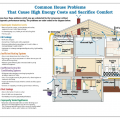
The Evolution of 3-D House Printing
In the ever-evolving world of construction, 3-D printing has emerged as a groundbreaking technology, promising a revolution in how we build homes. As of 2024, this technology involves using colossal printers to construct buildings layer by layer, using digital models. Think of it as your office printer but on steroids, swapping ink for materials like concrete, plastic, or metal. The charm of 3-D house printing lies in its speed and efficiency, potentially turning the tedious building process into a quick, environmentally friendly affair with minimal waste.
The Challenges: Not Just a Walk in the Park
However, let’s not put on our rose-colored glasses just yet. Despite its potential, 3-D house printing isn’t without its kinks and quirks. Here are a few hurdles it’s currently facing:
- Limited Materials on the Menu: Imagine going to a buffet with only one dish – that’s 3-D printing today. While concrete is the go-to material, it’s not always the best choice, especially in earthquake zones where it might just wave a white flag under stress. And let’s not forget, our current printers aren’t yet cool enough to print with wood or steel.
- Size Does Matter: Size limitations are like trying to fit a whale in a bathtub. Perfect for smaller projects, but when it comes to larger structures, 3-D printing is still sitting at the kids’ table. Plus, if you thought buying a regular printer was expensive, brace yourself for the sticker shock of their gigantic cousins.
- Design Complexity: Designing a 3-D printed building is like solving a Rubik’s cube, requiring expertise and patience. Any error can be a costly affair, not just in money but in time as well.
- Software Dependency: Heavily reliant on specialized software, 3-D printing in construction demands both technical skill and constant updates to keep up with the tech race.
- Regulatory Hoops: Navigating the maze of regulations in different areas can be as complex as a game of legal Twister, adding to the overall challenge.
- The Cost Conundrum: Although potentially more efficient, the initial investment in printers and materials, not to mention skilled labor, can make 3-D printing a pricey venture.
Looking Ahead
While 3-D printing in construction has its fair share of challenges, it remains a field ripe with potential. As technology advances and becomes more accessible, we may see these limitations shrink. For
now, though, it’s a technology that’s more suited to specific applications rather than a one-size-fits-all solution in the construction industry.
Embracing Future Possibilities
As we march into the future, it’s exciting to imagine how 3-D printing could evolve. Imagine printers that can handle multiple materials, or ones that can construct skyscrapers as easily as they do small homes. The potential for reducing environmental impact and speeding up construction times is huge, promising a greener and more efficient building process.
The Bottom Line
In 2024, 3-D printing in construction is like a teenager – full of potential but still finding its feet. It’s a fascinating field with much to offer, but it’s important to approach it with a realistic understanding of its current limitations and costs. For those willing to navigate its complexities and invest in its future, it could be a game-changer. But for now, it remains a work in progress, a glimpse into an exciting future of construction technology.























This article on 3D house printing is both insightful and thought-provoking! It highlights how this innovative technology could revolutionize the construction industry, making housing more accessible and sustainable. I’m excited to see how these advancements will shape our future!